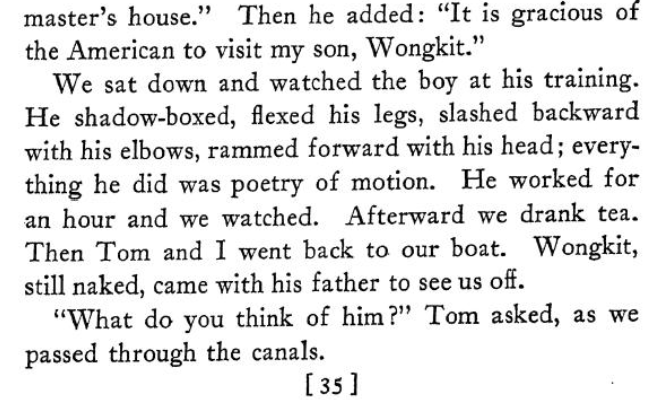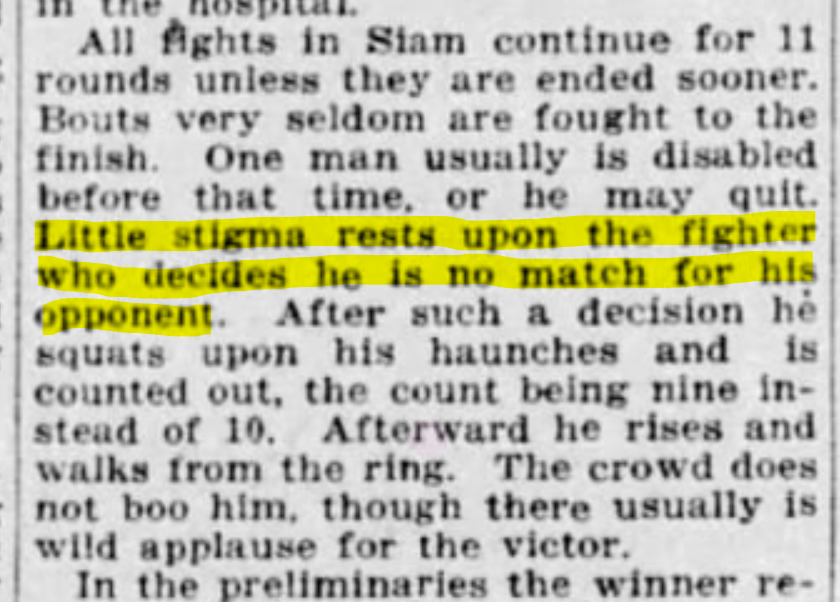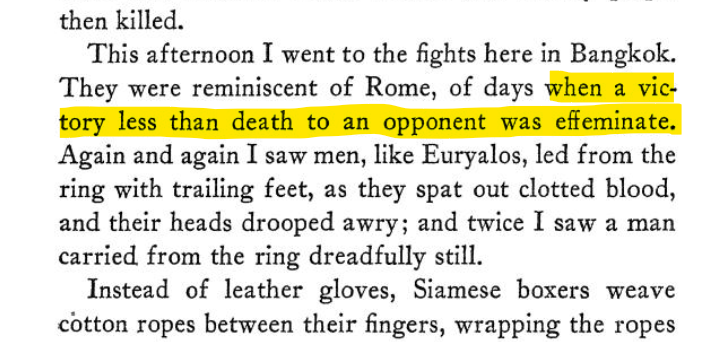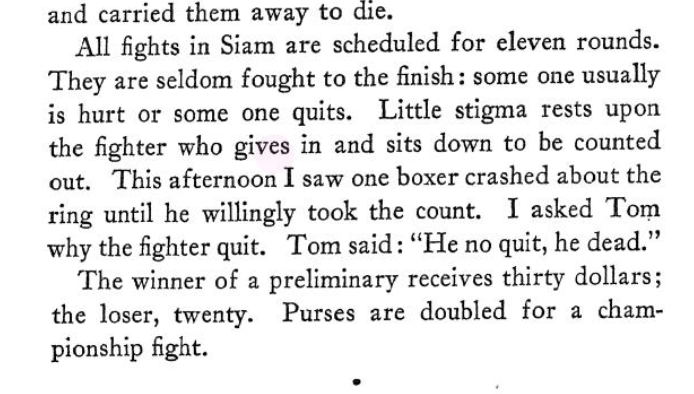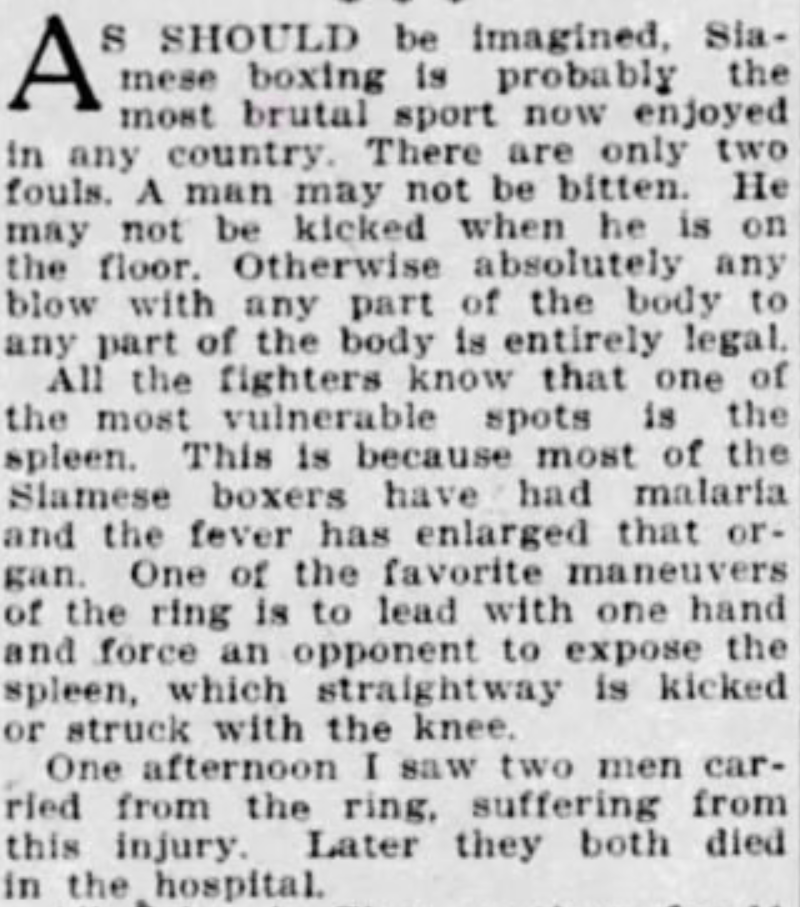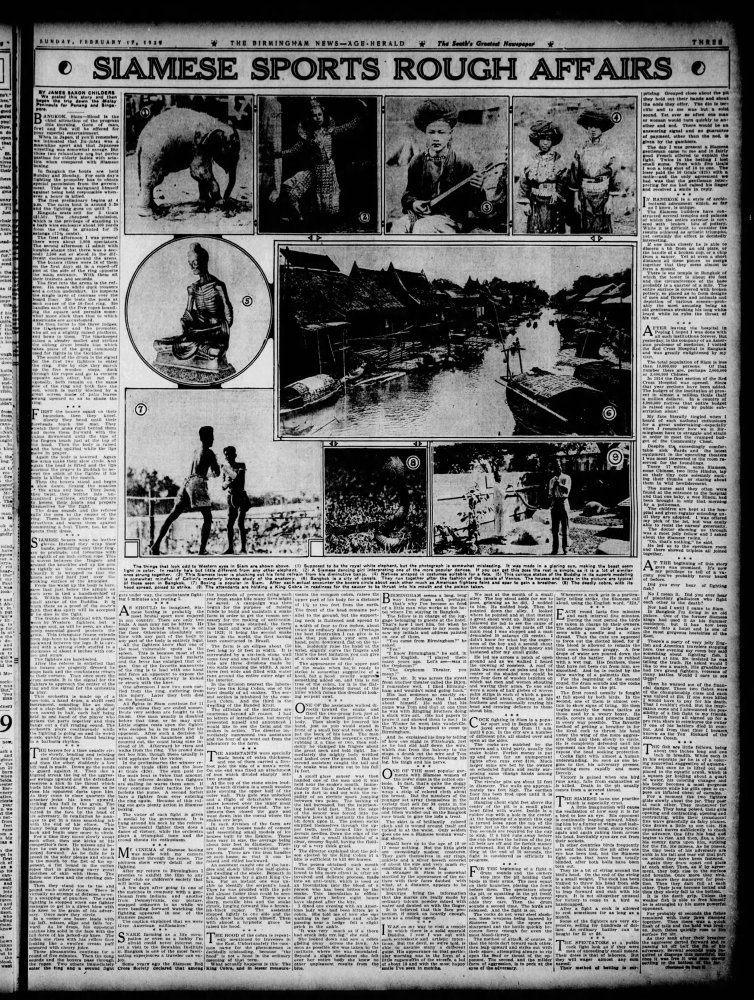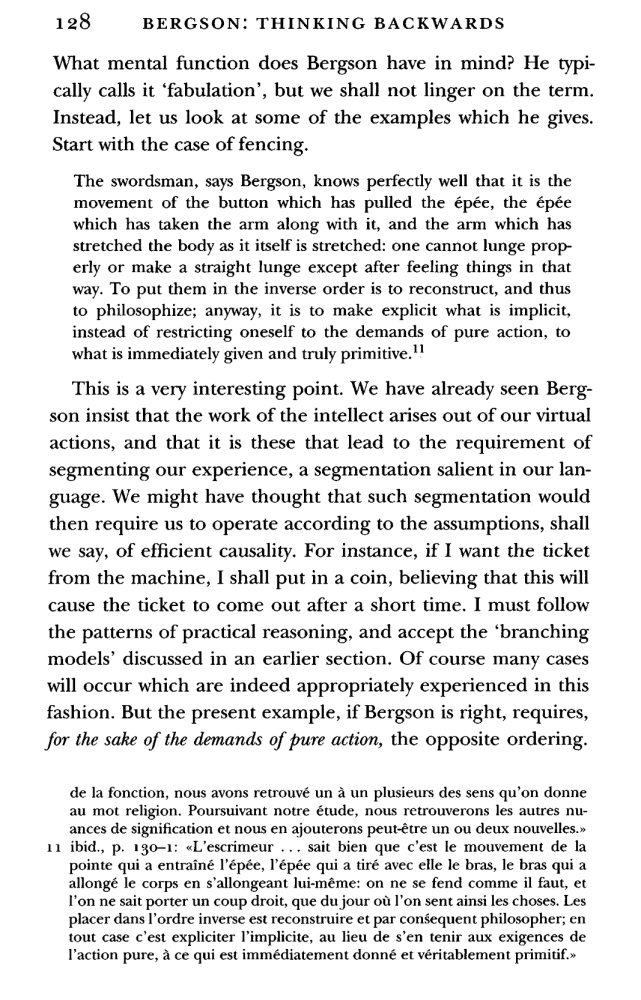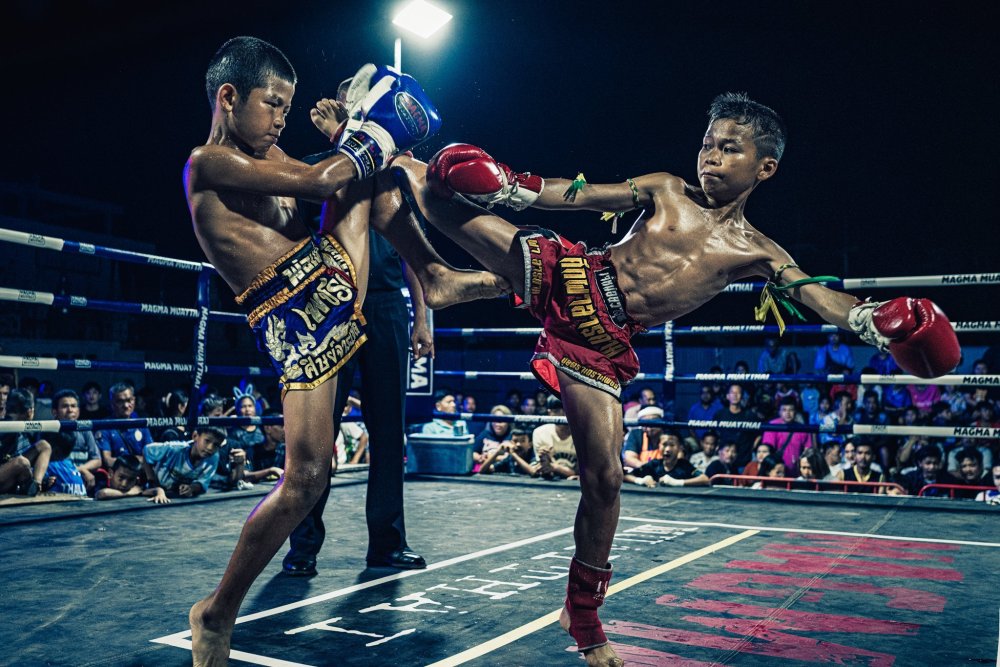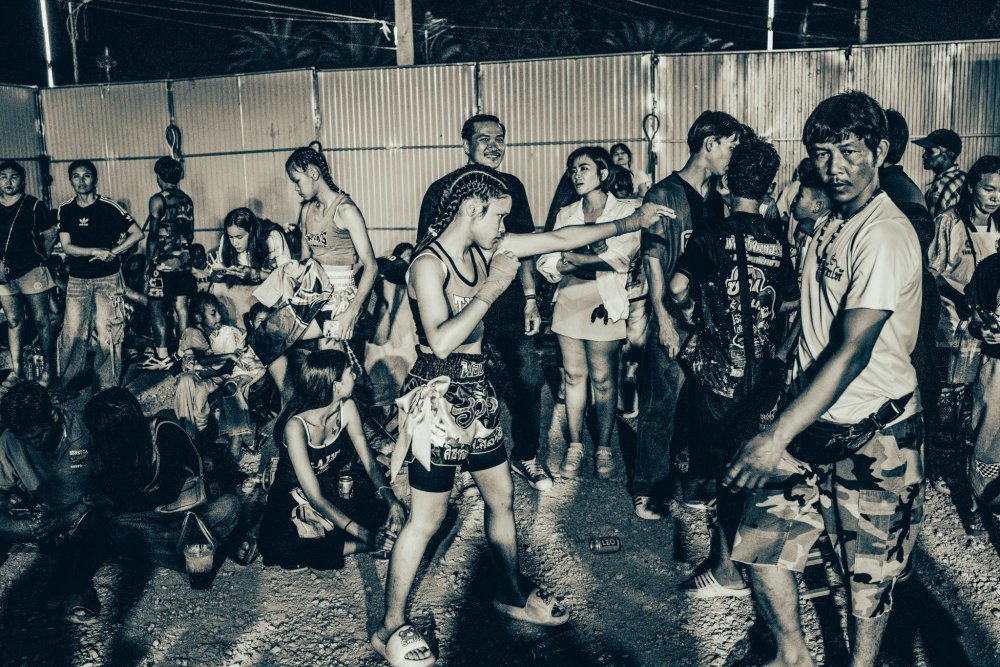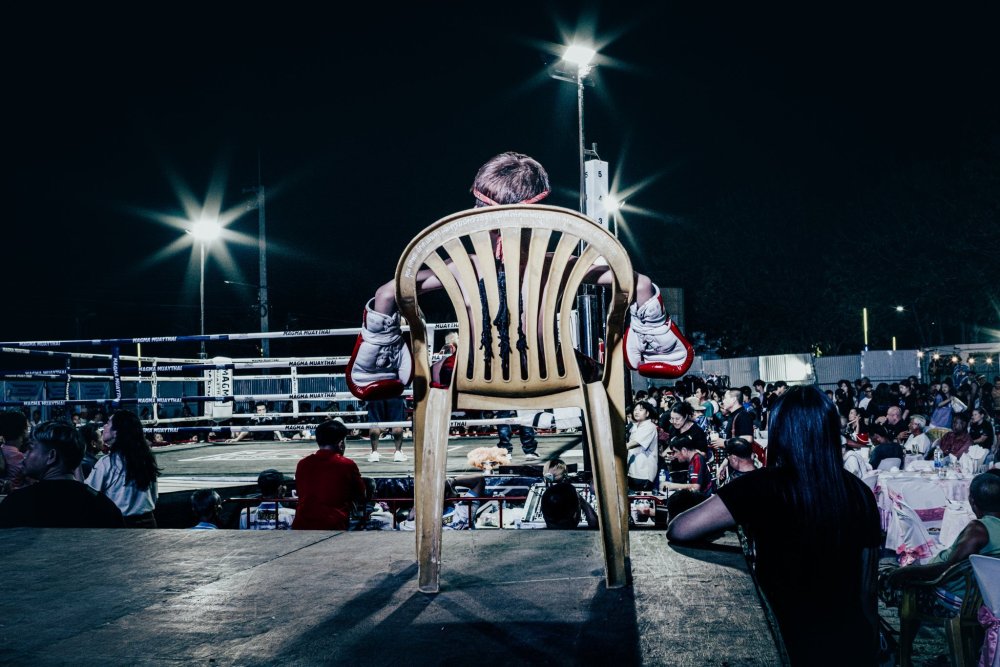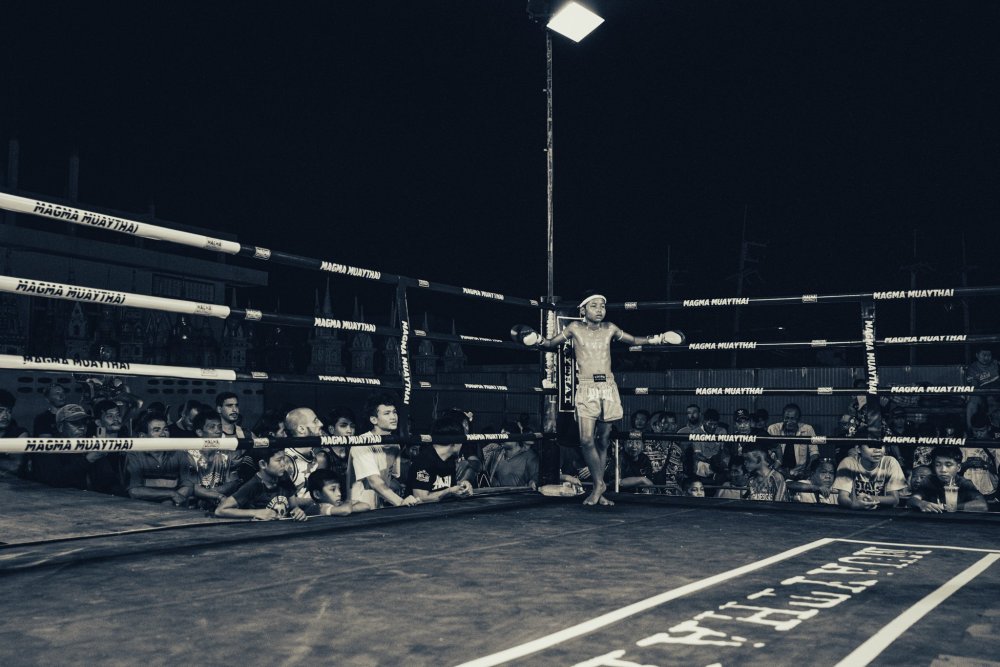All Activity
- Past hour
-
As Thailand's Muay Thai more and more turns its face toward the World and the West increasingly those coming to Thailand to seek out, experience, train in, fight in, even commit to and honor authentic Muay Thai will have a hard time finding it. In this brief article I want to point out the two biggest areas of difficulty. Keep in mind, I'm writing this from the perspective of having witnessed my wife who has fought more times in Thailand than any non-Thai history, coming up on 300 times, as a fighter who has steered as clear as possible from commercialized versions of the sport, and become perhaps the foremost documentarian of the sport and art. Everything I describe is from things we've encountered, found ourselves in, worked through, and what we've learned from the experiences of others. 1. Increasingly Thailand's Muay Thai is made FOR you One of the first challenges is honestly that of recognition. Because Thailand is so culturally different, and Thailand gym training different than Western and international gyms, whatever you are experiencing is going to feel authentic. Its authenticity will come through in everything that is different. It must be authentic because I'm not used to this. And because we can only judge from our own experiences, and from what we see and read, this is difficult to overcome. After 3 months in the country you are going to feel like you have really penetrated to the heart of something really new. After a year, you really will feel like you know what's going on, and if you have gravitated toward "authenticity" you'll probably feel like you are in a pretty "real" place. My caution is: Nope. You probably don't realize how much of Muay Thai has been turned toward YOU. And if it wasn't turned towards you, you wouldn't be participating in it. This is going to sound harsh, but pretty much ALL Western/International Muay Thai experiences are something like an elephant ride. The elephant (Muay Thai) is very real, and there is great privilege and beauty in being on an elephant...but you are on an elephant ride, made FOR you. Now, there are all sorts of elephant rides. There is the one where they walk in a circle and you get off, and maybe they kick a soccer ball, and then maybe all the way up to 10 day safaris, trekking on elephant back (are there such a thing?). But its still an elephant ride. How do I mean this? The rules of the sport have been changed so that you (in a less skilled way) will win fights, or perform well in fights you might not otherwise (there is a full spectrum of this, stretching from RWS entertainment Muay Thai to ONE smash and clash). The sport itself has been altered for you...and, as its been altered for you, this also has washed back onto trad Bangkok stadium Muay Thai, which has absorbed many of the entertainment qualities which are pervading social media and gambling sites. In some sense the "authentic" traditional Muay Thai of Thailand doesn't really exist in promotional fight form anywhere the halo of tourist and adventure tourist has reached. It's just a question of degree. (The issues and influences behind this in trad stadium Muay Thai are more complex than this, but it too has turned its face towards "the foreigner". Some of this is just what people like to call "progress" or "the force of the market place" or others might call the "deskilling of Capitalism", but just know that in the fights themselves, they are by degrees are turned towards YOU. It really might only be in the festival fight circuits of the provinces where you will still will find the culture and aesthetics of the sport and art FOR Thais. On a deeper level, the training in gyms is also made FOR you. The traditional pedagogy of Muay Thai, the manner in which it was developed through youthful circuit sidebet fighting, the kaimuay culture of non-correction and group dynamic sharing of a grown aesthetic, has been seriously eroded, supplimented and sometimes just outright replaced. You are (likely) not learning in the manner of the Thais that produced such acute excellence so many decades ago. Yes, there will be obvious things like farang krus and padmen in some gyms (many of them quite devoted to Muay Thai, but not produced by the subculture), something that is increasing in the sport, but, even if your padman is Thai, he may not even be an experienced ex-fighter, as mid-so Thais are holding pads now in the growing commercialization. Beyond padmen the very manner of instruction and fighter development will have been changed in some sense for you. For one, increasingly you'll notice "combo" training, memorized strike patterns, which is both a deskilling of the sport (making it easier to teach, replicate and export), but also is training that is geared towards the new Entertainment trade-in-the-pocket patterns and aesthetics, made for tourists and online fandom. The change in the rules of the sport over the last 7 years or so, also is reflected in a change in how the sport is actually taught...even in spaces that feel VERY Thai. The sport is bending to the "combo". Fighters did not train like that, nor did they fight like that. As the sport has become deskilled the combo has taken an increasingly important role. Added to this, gyms have had to accommodate the expectations of Westerners and other non-Thais, as the weakening of the sport economically has turned almost every gym in the tourism halo towards at least a hybrid relationship to tourism...it needs to give the Westerner something they recognize and expect...and, because tourists and adventure tourist come with all sorts of investments and motivations, on different timescales, a lower common denominator works itself into the equation. Group "classes", organized drilling of groups, increased conceptualization and rationalization of techniques involving verbal correction and demonstration, these are FOR YOU changes in the sport. Sometimes these trends and aspects will only be subtly present, sometimes they will characterize the entire process. This is an elephant ride. Along these lines of hunting the "authentic" training in gyms you'll run into this difficulty. You may be in a gym full of Thai fighters, even very active Thai fighters. There aren't many combos being held for. No real "group classes". A lot of Thai culture is going on, or seems to be. You are doing the work of fighters, real fighters, right there next to you. It's pretty authentic...but for these things. For one, this gym if its not a kaimuay in the more grassroots sense, all these fighters were made somewhere else. They were bought and brought into the gym, as part of a stable. So what you are seeing, and doing, isn't actually how they became what they are. They are in the polishing, or add-a-level stage. The heartbeat of what made them is elsewhere. Even if you are a developed, accomplished fighter, and you too are in the "polishing" stage, you don't have what they have, which is a very different history of training, fighting and development. They are made of a different material, so to speak, and in truth that "material" is the actual "stuff" that everyone comes to Thailand looking for, that is where the "authenticity" is in their movements, vision, rhythms, stylistics. You can do all the padwork, all the clinch rounds, all the runs, all the bagwork, all the sparing, and you'll get better, in fact a LOT better...but, you'll be missing that "authentic" piece, the thing they got before they came to this gym. To add to this, if you did seek out the kaimuay that grow fighters in the principles of the sport, and their fighting circuits, these are not economically robust spaces, they are not teaming with fighters. They are part of a fragmenting economy of provincial fighting, and in which is difficult to find one's place, especially as an adult, as they are made for youth. The best you might find are hybrid spaces, kaimuay on the low ebb, which also are run by a great kru, making room for non-Thais, but even these are a kind of bricolage of culture, knowledge and practice. There is no pristine location for the "authentic". A layer even further down in terms of authenticity, its not uncommon to feel that if you've stayed a lot, trained a lot, fought a lot, that you are being (more or less) "treated like a Thai". This is a big desire in the reach for "authenticity", and that experience of being "treated like a Thai" is therefore quite meaningful. But you aren't. You are still on an elephant ride, in a certain regard. And that's become Thailand's traditional Muay Thai is culturally founded on intense social power disparity. It is strongly hierarchized, and hierarchies vie against other hierarchies constantly in a political struggle that the Westerner, even the Thai speak Westerner largely cannot see...if if they see them, they cannot care about them in the same way a Thai does and would. This is a continuous struggle for social "position" in which the Thai fighter almost always has almost zero power. You do NOT want to be treated "just like a Thai"...and honestly, you probably can't be. The reason this is important is the almost all of the motivations you have as a fighter, to become better, to win, to be acknowledged are very, very VERY different than the Thai fighter kicking the bag right next to you...and their motivations are actually the "authentic" part of Thailand's Muay Thai. You can do all the work, mirror it beat for beat, but you are in the affective position of Thai fighters, and so in some sense cannot fight like them, for their alliances and values, the things which bring the strikes out, are largely invisible to the Westerner. All these things: that they've changed the rules so Westerners can win or perform well, and will enjoy watching, that they've changed the way Muay Thai is trained, that you aren't likely exposed to the actual processes that made stadium fighters who they are today, and even that you cannot experience the disempowerment, position and dignity of Thai fighters themselves, all cut off aspects of "authenticity", much sought by those that travel in earnest. This is leaving behind all those more common internet concerns like fake fights, dives, bad match making. Its in the actual fabric of the sport itself, as Westerners reach for it, and as it has turned its face toward the Westerner, making itself for the Westerner...and others. 2. The Fighters Aren't the Same The second difficulty in reaching for "authenticity" is that even if you get through all those layers. If you aver the combo, you identify kaimuay culture and its values and ways of life as much as possible, if you fight five round trad Muay Thai fights, don't take weight advantages when you can, if you emotionally connect with the low social position of the Thai fighter, all the things, and then make it to the ring where "authentic" Muay Thai is "happening"...its not even happening there. I mean this in this sense. Aside from the erosion and deskilling of the sport due to new promotional motivations, tourism and market pressures, Muay Thai itself has been eroding on its own. The rising economic standard out of the classes of people who traditionally fought it have changed many of the motivations and commitments of the fighters themselves, and the talent pool of fighters has dramatically decreased. I'm going to through a wild number out, but I'm just guessing in an educated way...maybe its 10x smaller. Leaving aside that combos and entertainment aesthetics are now working their way into more or less "Thai" gym spaces, the fighters themselves just are not that good, not as developed or accomplished by the time they are in Bangkok rings. Big name gyms grab up local kaimuay talent earlier and earlier (green fruit off the tree before ripe), the developmental fighter classes (informal groups) that grow the skills are seriously on the decline. A kaimuay may have had 20 fighting boys, now may have 3? This is to say, even if you can get all the way to the "authentic" rings, the quality and sophistication of the Muay Thai you will be facing will lack something that "authentic" dimension that characterized the freedom and expressiveness of skill of past generations. You may in fact fight a Thai who will fight quite like a farang (as far as it goes). Not only is the skillset diminished, but the rhythms and shapes of fighting that are "authentic" may not be there in full force. In some ways the Westerner may encounter a dim mirror of themselves. I'm writing this because this quest for authenticity is seriously meaningful. It's meaningful to us, those of the West who love Thailand's Muay Thai, and its also meaningful to Thais as well. The only way to significantly engage in the question of authenticity is to acknowledge that is already substantively hybridized. You and everyone else may be on elephant rides. It's only by identifying the aspects of Muay Thai that are not made for the tourist and adventure tourist, the threads of culture and practice that developed without your presence, or others like you, and nurturing with respect those aspects, that will the authentic journey begin. You may be in a very commercial gym, full of combos and group classes, but your padman probably grew up in kaimuay culture. It's in him. It's what made him. Find ways to connect to that. You may be in an Entertainment fight promotion, fight in the traditional style, try to win in the traditional style, even if the ruleset doesn't favor it. Push back against what has been made for you. Learn and identity the lineages of cultural practice that have defined Muay Thai, and connect to those purposely. In a certain sense, if we all realize we are on elephant rides, at a certain point you have have to love and care for the elephant itself, which is the beautiful, mysterious, almost-like-us, powerful, magical creature. And even if you aren't on the best ride, you are on a muther-effin elephant. Find the culture of the elephant. Find the elephant's history among the people. Find what the elephant needs. Find what is natural to the elephant. Protect and honor the elephant. we wrote a manifest of our values here
- Today
-
john smith joined the community
- Yesterday
-
Tech Support Dubai changed their profile photo
-
Tech Support Dubai joined the community
- Last week
-
Are you an Australian student looking for reliable and budget-friendly academic support? With increasing academic pressure, students often find it difficult to manage multiple assignments, especially in subjects like business and management. This is where management assignment help becomes an essential academic resource. Offering professional guidance on a wide range of topics such as strategic planning, leadership, and marketing, these services are designed to make your academic journey smoother. Many students now turn to Assignment Help Australia platforms that offer expert-written solutions at affordable rates. These services cater to university standards, ensuring that your assignments are not only plagiarism-free but also rich in content and formatting accuracy. Whether you’re in Sydney, Melbourne, or anywhere else, management assignment help Australia is easily accessible online. From improving your grades to saving you time, affordable management assignment help services are perfect for students who want quality without breaking the bank. Take advantage of expert assistance and stay ahead in your academic career with the most trusted Assignment Help Australia providers designed specifically for university students.
-
DavidtMiele joined the community
-
supergacor joined the community
-
Lesliusquet joined the community
-
viviantu joined the community
-
Watched this fight the other day, and as much as Wangchannoi is known as a hard-hitting Muay Maat, his hidden art is really the art of spoilage. Watch him spoil one of the great clinch attacks of the Golden Age. Among the many things that he is doing is that his punching and pinning Langsuan's collarbone on his right hand side grab (unusual for an orthodox fighter).
-
This is a line of reasoning I'd like to pursue, that global Capitalism is deskilling Muay Thai fighters, but changing the rules and aesthetics to breakdown complex fighting knowledge to repetitive tasks, like throwing memorized combos, in order to increase the labor force, making individual fighters less unique and more replaceable, and transfer the knowledge core to promotional and media oriented marketing. the chat gpt summary of deskilling: The argument that capitalism induces deskilling comes primarily from Marxist and critical labor theorists, particularly Harry Braverman, who expanded on this in his influential 1974 book Labor and Monopoly Capital. Here's a breakdown of the argument: What is Deskilling? Deskilling is the process by which skilled labor is replaced with less skilled or unskilled labor—often through: Technology or automation Standardization of work tasks Fragmentation of complex jobs into simpler, repetitive tasks Why Would Capitalism Encourage Deskilling? 1. Profit Maximization Capitalist firms aim to maximize profits. One way to do this is to: Replace skilled workers (who are more expensive) with less skilled workers or machines Simplify tasks so they require minimal training, which reduces labor costs 2. Managerial Control Simplifying jobs increases management’s control over the labor process: Skilled workers often have more autonomy and bargaining power Deskilling reduces workers' independence and makes them easier to supervise, replace, and discipline 3. Increased Productivity Deskilled labor allows for: Mass production techniques (think Ford’s assembly line) Faster and more consistent output Easily interchangeable workers, which supports scalability Theoretical Roots Karl Marx: Believed capitalism alienates workers from the labor process, reducing their work to mere repetitive actions Harry Braverman: Argued that capitalist development deliberately strips away workers’ skill and knowledge to concentrate power and expertise in management
- Earlier
-
U9 Play joined the community
-
sweetpiamidwifery joined the community
-
carmelina91 joined the community
-
Simpliaxissolutions changed their profile photo
-
small note, it is interesting to see a 1930s account of an hour of shadowboxing: It reminds me of Yodkhunpon's account of building his Muay Thai out of countless hours of shadowboxing, due to his lack of equipment or even explicit training in his rural village. The tale of endless shadowboxing goes back 100 years.
-
Not sure if Childers book (1932) is far more romantic and florid than his Newspaper report (1929), but there is some contradiction in descriptions of fighters who "quit" (just acknowledge the opponent superior). The newspaper article: The book: the book then recounts the Newspaper report that there is no stigma in quitting...but then immediately reverses the moment of quitting, into death. This is one of the problems with Western reports at the time (and even fight footage), they have a kind of compulsion toward the florid because they want to report their experiences as incredibly exotic, like nothing a "civilized" man would ever see. And...they just indeed experience everything as quite exaggerated, as they were in very alien environments and everything as disorienting. This author seems to portray death as fairly common in the Kard Chuek ring, and it may have been (but he struggles to make coherent sense of the fighter who just sits down without stigma)...but by report King Rama 7 in 1928 banned glove-less fighting in response to a death in a fight at the city pillar, which seems like an unlikely reason if deaths were quite common...though speculating perhaps it was a "civilizing" moment, that particular death, depending on particular reactions from Western visitors? In his newspaper article Childers claims to have watched two fighters suffer spleen injuries who later died in the hospital, in his book he seems to have turned one of these into a death that he watched happen in the ring, of a boy in his "first fight" (this seems quite dubious), a boy who he watched train, who wanted to come to America. The propensity for embellishment (if not outright fabrication) seems strong with this writer.
-
As noted in private communication, this newspaper account seems like it captured one of the last fights in the Kard Chuek era in Bangkok: It is interesting that the Childers newspaper article (1929) captures the time right went all glove-less fighting was reportedly banned by Rama 7 (1928) in Bangkok. The fight (possibly from 1928) was gloveless. He may have been reporting on one of the last gloveless fights of Bangkok (or, the decree was very unevenly enforced (more likely). https://8limbsus.com/blog/modernization-muay-thai-timeline
-
This is a very interesting small section which may help explain a very fundamental difference between Thailand's Muay Thai and many other combat sports. Westerners in particular who favor hand-strikes have a hard time understanding Thailand's orientation to the body, especially the high scoring of knees and kicks to the body. This in part can be explained by a Siamese/Thai sense of the body which places the "self" in the torso, something many ancient cultures have and which we retain in thoughts like "he had 'guts'" or a "gut feeling". It seems that indeed the center of the person in Thai culture, his or her life-force is seen in the torso, and not in the "face" or "head", just as a matter of body mapping. But, here the wide-spread presence of malaria and the enlargement of the spleen (and liver) from malaria would even further explain the development of a kicking and kneeing fighting art, as these organs would be even more vulnerable...even by Childers account, life-threatening (never knowing if reports get exaggerated for foreign interests). The two aspects, the traditional centering of the life force in the torso AND the vulnerability of the spleen and liver may actually go hand in hand, one imagines. This is a very cool observation. From material facts, even the effects of disease, an entire sophistication of attacks by knees and kicks may have developed, one not reducible to those specific vulnerabilities, as the aesthetic and the skills developed along their own paths. Notably, being able to control and protect the center of the body indeed likely unlocks many aspects of the spatial control of opponents, regardless of the vulnerability of specific organs. Malaria may have actually attenuated awareness which lead to high-order understanding of fighting itself. Malaria may have been in Southeast Asia for 1,000s of years.
-
I am researching and writing an action oriented screenplay set aboard a three-island tramp steamer anchored off the unnamed coast of a country modelled after Cambodia (originally set in 1953, but as I’m developing it, transforming it more into a fable with a non-specific time period, so at a time between 1920 and 1953). Two of the crew members on board are the Thanikul brothers, Siamese twins, but bodily-fused only metaphorically. They are Siamese Boxers who box against each other in a make-shift boxing ring on the ship’s closed cargo hatch. I’d love to know of any sources (books or articles) in English recounting the history of Muay Thai or Muay Boran from the period between 1920 and 1953. Have any Thai sources about Muay Boran from that period been translated into English? Any writers’ names I should know of that period who wrote about this martial art? I just want to get a feel for the attitudes of the people of this period about Siamese Boxing, both the colonialists and the locals. I remember seeing a live Muay Thai match in Bangkok at a small outside ring, somewhere in Bangkok in 1996, as a tourist when I was living in Japan in the late ’90s. Can’t remember exactly where that was. Thank you in advance for any information you could provide! Cheers, - Jeff
-
The 1929 newspaper article was written by American travelogue author James Saxon Childers who went on to write and publish the book "From Siam to Suez" in 1932, detailing his adventures in Thailand and some his time spent watching Siamese boxing bouts. The book is in the public domain and available to view and for free download from the Internet Archive, here: https://archive.org/details/fromsiamtosuez010141mbp His accounts of Siamese boxing begin in Chapter IV, starting on page 22. And again in Chapter VI, starting on page 31. In the Birmingham News newspaper article, he mentions that 2500 spectators sat or stood in the different enclosures around the Bangkok arena. Any idea where it would have been located?
-
The 1929 newspaper article was written by American travelogue author James Saxon Childers who went on to write and publish the book "From Siam to Suez" in 1932, detailing his adventures in Thailand and some his time spent watching Siamese boxing bouts. The book is in the public domain and available to view and for free download from the Internet Archive, here: https://archive.org/details/fromsiamtosuez010141mbp
-
Really enjoyed the Mongkutpetch slow rolling control and domination of the Payahong Raja belt fight. Especially in the first 3 rounds it was methodical, and her size, knee threats and the joining of the hands in the clinch just gradually swallowed Payahong up. Payahong was never really a plus clinch fighter, her strength is timing and kicking, and composure, so one that space was consistently invaded there was little she could do to change the tide. It was great how unrushed Mongkutpetch was.
-
Think of the highest level of Muay Thai fighting 30 years ago, in the Golden Age, in terms of Dynamic Range, as its applied to photography or sound recording. Fighters were able to perform skillfully at an intense range of distances. It wasn't just a matter of styles, it was that every distance was within the spectrum of competence or even excellence. With the advent of Entertainment Muay Thai, as Thailand seeks to fashion its sport towards the less skillful foreigner, the real aim is to reduce the dynamic range of fighting to only "the pocket" as much as possible, to generate clashes, because that's where memorized combinations favored by Western and other nationalities are the most effective, and that is where large bodied fighters will win exchanges. The entire spectrum, the Dynamic Range of fighting is to be shrunk. And the ranges were Thais especially held court, too-far (counter kicking defense) and too-close (clinch dominance) have been clipped out.
-
Ella12 changed their profile photo
-
babu88 changed their profile photo
-
Some beautiful examples from the Contax 645, from Rambaa's festival card this week, where you can feel both the space AND the details, more than I even intuited. This to my eye is very close to a "natural" view, with just a little artifice to give it that oneiric feeling, which is related to my larger Noir sensibilities.
-
Muay Khao for short fighters
dtrick924 replied to giri's topic in Muay Thai Technique, Training and Fighting Questions
I'm not sure which video you watched but Sylvie has a whole clinch playlist Hop In Clinch Entry Getting in & Staying In Clinch Basics Seminar -

Muay Khao for short fighters
FuckedElbow-Muay replied to giri's topic in Muay Thai Technique, Training and Fighting Questions
Sylvies clinch work is great. The technique i explained is very similar to a basic clinch, i'm sure you will figure it out -
Muay Khao for short fighters
giri replied to giri's topic in Muay Thai Technique, Training and Fighting Questions
I watched Sylvie's clinch video. I think I can relate to what you're saying. I'll practice and see if I can figure how to execute it. -

Muay Khao for short fighters
FuckedElbow-Muay replied to giri's topic in Muay Thai Technique, Training and Fighting Questions
No worries! If you are unsure of the hand positioning in the clinch with this move, i can try to find some or maybe take a picture of it, it is a bit difficult to explain and understand movement correctly through text. -
Muay Khao for short fighters
giri replied to giri's topic in Muay Thai Technique, Training and Fighting Questions
Thank you. Let me study in detail. -

Muay Khao for short fighters
FuckedElbow-Muay replied to giri's topic in Muay Thai Technique, Training and Fighting Questions
I'm not sure about Sylvies approach to this, and can't really relate since i ain't that short, but i might have a small tip on closing the distance relatively safely in order to use knees.. It might be a bit clumsy to explain this in text, but i'll try. Try to push your opponent away with a teep, then follow up with a jab, you don't have to hit them with the jab, this is mainly to measure distance and maybe make them shell up a bit, then close the distance with a knee feint with your left knee, use the movement as you put your left foot on the ground again, step to the right of your opponent and try to grab them. Left hand upside down behind their neck, right arm on the outside of their bicep, use your strength to push their head downwards as you would in a normal clinch. If you do this fast enough, you will have very good controll of their body and they are in a pretty vulnerable position to take left knees in the stomach. When they try to push you away, you are also in a pretty good position to follow of with a sweep with your right leg as they step back, you will have maybe a second or so to do this as they gain their composure again, and you are still in the dominant position. I don't know how much you will understand of this as it is in text, but this has worked pretty good for me against taller opponents. But it is of course not withouts it's risks, every move is possible to counter. You might want to try this in a shadowbox routine before you apply it to sparring.
Footer title
This content can be configured within your theme settings in your ACP. You can add any HTML including images, paragraphs and lists.
Footer title
This content can be configured within your theme settings in your ACP. You can add any HTML including images, paragraphs and lists.
Footer title
This content can be configured within your theme settings in your ACP. You can add any HTML including images, paragraphs and lists.
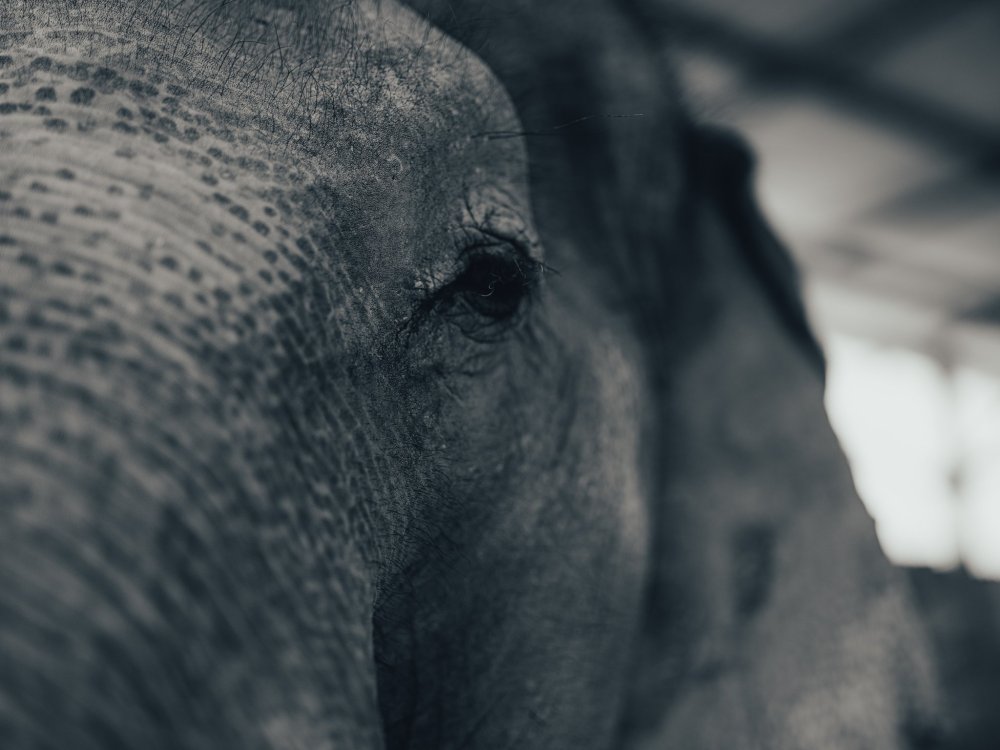




.thumb.jpg.57fed8622ca16a6926960d557e8307ae.jpg)
